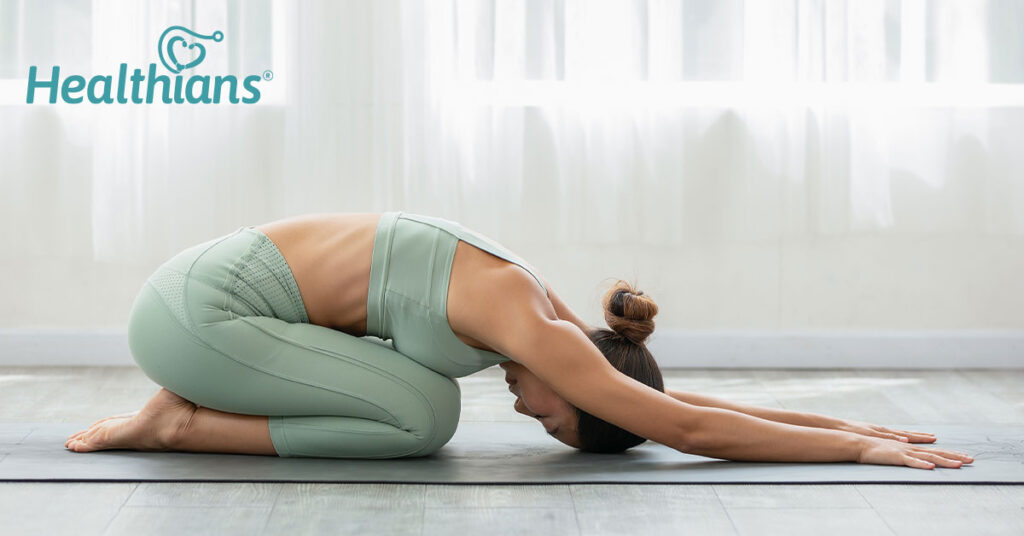Introduction
Everyone experiences an occasional ache and pain. However, chronic pain is not the same as typical pain. Chronic pain can be a debilitating condition that affects millions of people around the world. The pain is ongoing and may last from several weeks to years. It may be sharp or dull, steady or intermittent. It may come and go without any apparent reason. The pain may impact your day-to-day activities.
While there are various treatments available, many people are turning to yoga as a way to alleviate pain and improve their overall health and well-being. Studies have demonstrated that yoga can be an effective way to manage chronic pain by promoting relaxation, reducing pain perception, decreasing inflammation, and improving flexibility and mobility.
In this blog, we will discuss some yoga postures that have been found to be effective in relieving chronic pain. But, before that, let’s look at some of the most common causes of chronic pain.
· Injury or traumatic incidents such as a car accident, fall, or sports injury.
· Nerve damage that may be caused by neuropathy
· Inflammation due to conditions such as arthritis, Crohn’s disease, or fibromyalgia
· Symptoms of certain medical conditions, such as multiple sclerosis, Lyme disease, or cancer
· Psychological and emotional factors such as pain-related anxiety, anger, depression, stress
· A genetic predisposition to chronic pain conditions, such as fibromyalgia or chronic migraines.
· Certain lifestyle factors, such as lack of exercise, poor diet, or obesity
Five easy yoga poses that can help alleviate chronic pain
1. Child’s Pose (Balasana)
This is a gentle and relaxing pose that can help relieve tension in the back, neck, and shoulders. It also helps to gently stretch the hips, thighs, and ankles.
· To do this pose, start on your hands and knees.
· Bring your big toes together and separate your knees wide.
· Lower your hips towards your heels and stretch your arms out in front of you.
· Rest your forehead on the ground or on a pillow if it doesn’t reach.
· Hold for 5-10 deep breaths.
2. Downward-Facing Dog (Adho Mukha Svanasana)
This popular pose stretches the entire body, including the hamstrings, calves, shoulders, and spine. It helps to relieve pain and stiffness in the back, neck, and shoulders.
· To do this pose, start on your hands and knees.
· Tuck your toes and lift your hips up and back, straightening your arms and legs into an inverted V-shape.
· Spread your fingers wide and press your hands and feet into the ground.
· Hold for 5-10 deep breaths.
3. Cat-Cow Pose (Marjaryasana-Bitilasana)
This gentle flowing movement can help loosen up the spine and alleviate pain in the neck, shoulders, and back.
· To do this pose, start on your hands and knees.
· Inhale, arch your back and lift your tailbone and head up towards the ceiling (Cow Pose).
· Exhale, round your spine and tuck your chin into your chest (Cat Pose).
· Continue flowing between these two poses for 5-10 breaths.
4. Pigeon Pose (Eka Pada Rajakapotasana)
This pose stretches the hips and can help alleviate pain in the lower back, hips, and knees.
· Start in Downward-Facing Dog.
· Bring your right knee forward and place it behind your right wrist.
· Stretch your left leg back behind you.
· Lower your hips towards the ground and fold forward over your right leg.
· Rest your forehead on the ground or on a pillow if it doesn’t reach.
· Hold for 5-10 deep breaths, then switch sides.
5. Standing Forward Bend (Uttanasana)
This pose stretches the hamstrings and can help relieve pain in the lower back.
· To do this pose, stand with your feet hip-distance apart.
· Fold forward from your hips, keeping your knees slightly bent if needed.
· Let your head and arms hang towards the ground.
· Hold for 5-10 deep breaths.
Final thoughts
Yoga has been demonstrated to produce behavioural, physiological, and psychological changes in pain management. However, it is recommended that you should listen to your body and only undertake movements that are within a comfortable range of motion. If any pose causes pain or discomfort, stop and modify as needed or consult a yoga teacher or healthcare professional.





